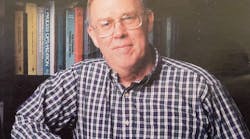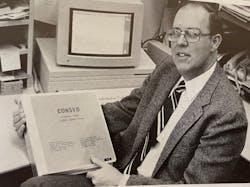Since you’re reading this, there’s a chance you crossed paths with W. Harmon Ray. If you studied at the University of Wisconsin-Madison, you may even have been taught by him. In fact, some Process Automation Hall of Fame members at the university were Ray’s colleagues.
He’s a chemical engineer, control theorist and applied mathematician, who served as a Vilas Research professor at the university. In 2000, he won the prestigious Richard E. Bellman Control Heritage Award for distinguished career contributions to the theory of application of automatic control, and in 2019, he won the Neal Amundson Award for excellence in chemical reaction engineering.
Now retired and enjoying life with his wife, Nell, Ray reflects on a long and distinguished academic career. He says he was lucky to parallel the evolution of computer systems in engineering. In fact, it was the chance to work with those new computers that got him into the field in the first place, when he went to college at Rice University in Houston in the late 1950s.
“I was lucky to begin my chemical engineering studies just as computers were starting to being used,” he recalls. “My undergraduate study was at Rice University, which built its own computer. I learned to program it, giving me computer skills, and I also was introduced to mathematical modeling.”
Ray continued to hone his computer modeling skills after graduation. He headed to the University of Minnesota, where Neal Amundson and Rutherford Aris were at the forefront of applying mathematics and computers to engineering problems. Given his piqued interest in both, he knew there was no better place to do his post-graduate work. “My work with Aris combined computer skills with modeling and control of chemical reactors,” he says.
He explains his interest in computer modeling stemmed from his interest in exploring new things. “It was a blank slate. If you had a new idea, you could explore it,” he says. “You had the whole field to explore.”
With a bit of a chuckle, Ray adds he kept his trusty slide rule with him. “Computers were homemade. They were quite large at that point.” Mobil computing was still decades and a few brash Silicon Valley entrepreneurs away from reality.
His post-graduate experience opened several options for the young engineer. However, he was hooked on the possibilities of computer computations in engineering applications, so he opted for academia rather than industry. “I decided to look for an academic position, rather than an industrial position, so I could have the freedom to choose which areas of research to pursue,” he recalls. “When I graduated from Minnesota, the University of Waterloo in Canada had the most up-to-date computer facilities in North America. Later, I moved to the State University of New York (SUNY) at Buffalo and then to the University of Wisconsin.”
Ray quickly began to make a name for himself as a researcher, particularly in modeling chemical processes. “Computers opened whole new areas of engineering. By modeling chemical processes, once you understood them, you could learn what was needed to control the process to get the desired outcome,” he explains. “This required software development to use data about mechanisms, kinetics, properties, operating conditions, potential problems to produce desired products, and do so efficiently and safely.
“The modeling and control of polymerization processes led to the field of polymer reaction engineering and the development of our Polyred computer program. For any polymer or reactor, we could predict results under given operating conditions and, by varying various parameters, obtain the optimal operating policy. We could test the accuracy of the program in our own polymer lab.”
As industry became aware of the power of computers to improve products and methods, Ray did a lot of consulting in addition to his research and teaching. “I believe that such interactions between academia and industry are vital and beneficial to both,” he says.
Ray adds these opportunities allowed him to not only contribute his expertise, but also learn about the practical problems industry encountered. That meant his students had the benefit of working on new technologies and relevant problems.
Because the field was so new, Ray was able to attract the very best students and other researchers to his group, as well as research funds to support it. “My greatest satisfaction has been working with so many truly exceptional people, and seeing them go on to make significant contributions to both academics and industry,” he says.






